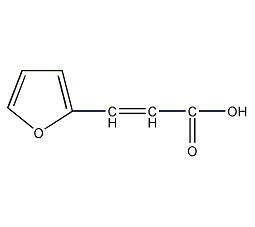3-(2-furyl)-2-propenoic acid


Structural formula
| Business number | 05JQ |
|---|---|
| Molecular formula | C7H6O3 |
| Molecular weight | 138.12 |
| label |
2-Furylacrylic acid, synthetic raw materials, Intermediates |
Numbering system
CAS number:539-47-9
MDL number:MFCD00003257
EINECS number:208-718-8
RTECS number:LT8560000
BRN number:81046
PubChem number:24856659
Physical property data
1. Properties: Obtain needle crystals from water.
2. Density (g/ cm3, 25/4℃): Undetermined
3. Relative steam density (g/cm 3, air=1): Undetermined
4. Melting point (ºC): 139-141
5. Boiling point (ºC, normal pressure): 286, 117ºC (1.06kpa)
6. Boiling point (ºC, 8kPa): Undetermined
7. Refractive index: Undetermined
8. Flash point (ºF) : 286
9. Specific rotation (º): Undetermined
10. Autoignition point or ignition temperature (ºC): Undetermined
11. Vapor pressure (kPa, 25ºC): Undetermined
12. Saturated vapor pressure (kPa, 55.1ºC): Undetermined
13. Heat of combustion (KJ/mol): Undetermined
14. Critical temperature (ºC): Undetermined
15. Critical pressure (KPa): Undetermined
16. Oil and water (octanol/water) Log value of distribution coefficient: Undetermined
17. Explosion upper limit (%, V/V): Undetermined
18. Explosion lower limit (%, V/V): Undetermined
19. Solubility: Easily soluble in ethanol and ether.
Toxicological data
1. Acute toxicity: mouse intraperitoneal LD50: 276mg/kg, no detailed description except the lethal dose;
2. Mutagenicity data: TEST system mutation of microbial organism: bacteria – Salmonella typhimurium Bacillus sp.: 10 ug/plate;
Ecological data
This substance may be harmful to the environment, and special attention should be paid to water bodies.
Molecular structure data
1. Molar refractive index: 36.00
2. Molar volume (cm3/mol): 107.8
3. Isotonic specific volume (90.2K ): 286.0
4. Surface tension (dyne/cm): 49.4
5. Polarizability (10-24cm3): 14.27
Compute chemical data
1. Hydrophobic parameter calculation reference value (XlogP): 1.2
2. Number of hydrogen bond donors: 1
3. Number of hydrogen bond acceptors: 3
4. Number of rotatable chemical bonds: 2
5. Number of tautomers:
6. Topological molecular polar surface area (TPSA): 50.4
7. Number of heavy atoms: 10
8. Surface charge: 0
9. Complexity: 151
10. Number of isotope atoms: 0
11. Determine the number of atomic stereocenters: 0
12. Uncertain number of atomic stereocenters: 0
13. Determine the number of chemical bond stereocenters: 1
14. The number of uncertain chemical bond stereocenters: 0
15. The number of covalent bonding units: 1
Properties and stability
1. Use and store according to specifications. It will not decompose and avoid contact with oxides.
2. Exist in smoke.
Storage method
Stored in a cool, dry and well-ventilated warehouse. Keep away from fire and heat sources. Protect from direct sunlight. The packaging is sealed. They should be stored separately from acids and food chemicals, and avoid mixed storage. Suitable materials should be available in the storage area to contain spills.
Synthesis method
1. Obtained from the reaction of furfural and malonic acid. Add furfural and malonic acid to pyridine, heat to reflux for 2 hours, cool, add water, and add concentrated ammonia while stirring until the acid is almost completely dissolved. Filter the solution, wash the filter cake with a small amount of water, combine the filtrate and washing liquid, acidify with hydrochloric acid, and then heat on a boiling water bath for 1.5-2 hours. The precipitated precipitate is filtered out, washed with water, and dried to obtain the finished product, with a yield of 90-92%. 2. Obtained from the oxidation of furanoacrolein [623-30-3] and acid precipitation. Add the mixture of water, furanocrolein, silver oxide and water to the reaction pot, and introduce oxygen at about 25°C while stirring. After 10 minutes, add 35-50% sodium hydroxide solution dropwise, add 1/2 of the amount within 1 hour, and the temperature is lower than 40°C. Add the other half of the sodium hydroxide solution within 10 minutes, then add oxygen for 10 minutes, and control the pH to 11-12, cool to below 40℃, discharge and filter. The filter cake is silver oxide and is applied after washing. Adjust the washed and filtrate to pH 3 with hydrochloric acid, heat to 90°C to dissolve all the precipitated furanoacrylic acid crystals, then cool to 30°C to precipitate the crystals, filter, wash with ice water, and dry to obtain furanoacrylic acid. 3. Obtained from the condensation of furfural and acetic anhydride. In a dry reaction pot, add acetic anhydride, furfural and anhydrous sodium acetate, stir and reflux at 150°C for 7 hours, add crushed ice, and filter out the crude product. The crude product is suspended in hot water and heated, and alkali is added to adjust the pH to 5.9-6. After the crude product is completely dissolved, add activated carbon to decolorize at 90°C, filter, adjust the filtrate to pH 3 with hydrochloric acid at 50-60°C, precipitate crystals, filter, wash with water, and dry to obtain furanoacrylic acid. In addition, furfural and acetone are condensed in a sodium hydroxide solution to first obtain furfurylidene acetone, and then oxidized with bleaching powder to obtain the product, with a yield of more than 65%.
Purpose
Furanoacrylic acid is an intermediate for furopyramide, a drug used to treat schistosomiasis. It is also used to prepare heptanedioic acid, pimelic acid, vinyl furan and its esters, etc.
